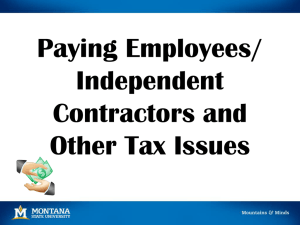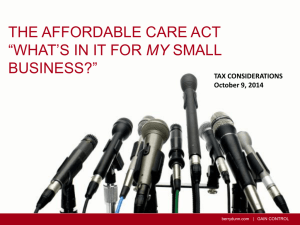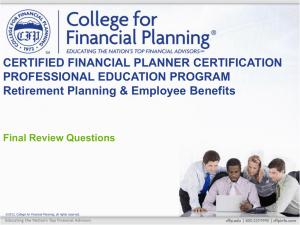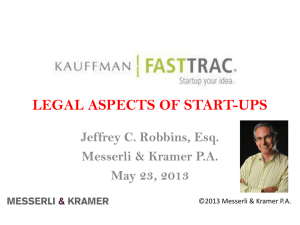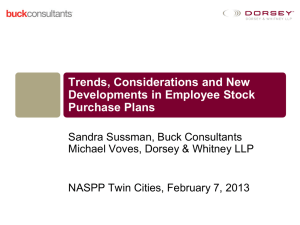AP: Taxable vs Non Taxable Fringe Benefits
advertisement
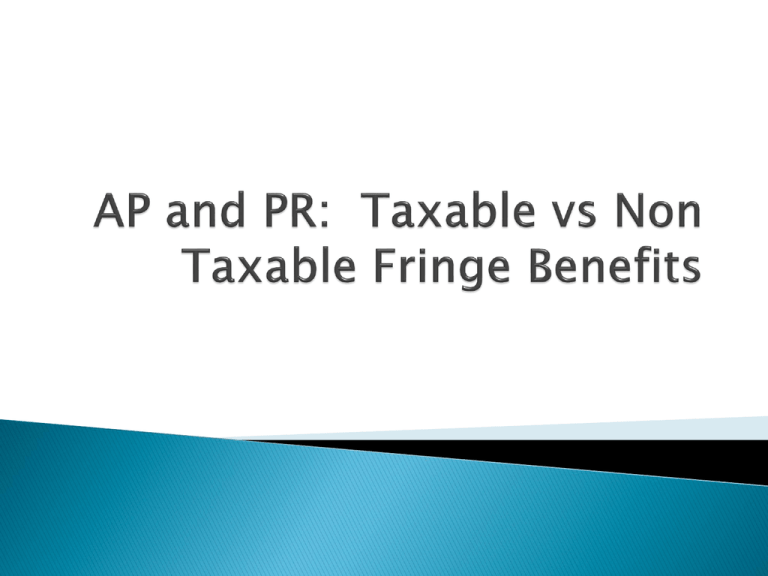
Gross income is income from whatever source derived (IRC section 61) Fringe benefits or “perks” provided to employees are included in income as wages unless expressively exempted under the IRC AP often issues checks to pay for fringe benefits or reimbursements to employees or contractors 2 Wages are subject to tax withholding, FICA, FUTA, W-2 reporting, state and local withholding payroll taxes Compensation to independent contractors is reportable on Form 1099-MISC, Box 7 3 ◦ ◦ ◦ ◦ ◦ ◦ ◦ ◦ No additional cost services Qualified employee discounts Working condition fringes De minimis fringes Qualified transportation fringes Qualified moving expenses Qualified retirement expenses Qualified military base realignment and closure fringes 4 Non-Taxable Employee Expense Reimbursements – Accountable Plan Accountable expenses • Must have receipt • Show business connection Non-Accountable expenses • Per Diem Allowance - varies from city to city - see pub. 1542 from IRS • Mileage reimbursement up to 56.5¢ per mile - anything over must be taxed (Jan 1, 2013) • De Minimis up to $75.00* Most “allowances” are taxable Cash - taxable Gift Certificates – usually taxable Tangible Property – nontaxable if de minimis Achievement Awards ◦ ◦ ◦ ◦ Safety or Service Tangible property only Up to $1600 –non-taxable if qualified plan Up to $400 – non-taxable if not qualified No-Additional-Cost Service Services offered for sale to customers in ordinary course of business of the employer in which the employee is performing services Employer incurs no substantial additional cost in providing service to the employee Take lost revenue into consideration when determining whether substantial additional cost is incurred Qualified Employee Discounts Discount given to employees on qualified property that does not exceed profit margin, or on qualified services that do not exceed 20% of the price offered to customers Qualified property or services - personal property or services provided to customers in the ordinary course of business Does not include real property or personal property held for investment Qualified Employee Discounts “Employee” includes current and former employees who left because of retirement or disability, and their widow(er)s, spouses, and dependent children Company discounts must be followed if the employee is highly compensated (see Notice 2007-87, 2007-45 I.R.B. 966) Qualified employee discounts must be provided on a non-discriminatory basis Working Condition Fringe • Property or service provided to an employee to the extent that, if the employee paid the expense, it would be deductable under IRC Sec. 162 or 167 • The term “employee” includes a current employee, partner who performs services, director, or independent contractor Examples of working condition fringes •Business travel •Business use of a company car or airplane •Chauffeur or body guard provided for security protection •Club dues and membership fees for professional organizations •Outplacement services Business use ◦ Substantiation ◦ Written policy Personal use ◦ Commuting ◦ De minimis 12 • Personal use by employee or family member included in income • Valuation depends upon primary purpose of flight and whether employee is a “control employee” • Value determined by FMV unless Standard Industry Fare Level formula is elected • In June 2007, proposed regulations issued (REG147171-05) relating to deduction for business use of aircraft for entertainment purposes 13 • • Must have a bona fide business-oriented security concern and an overall security program (24-hour basis or security study) for the employee to exclude the excess of the value of the transportation provided by the employer over the amount that the employee would have paid for the same mode of transportation absent the bona fide security concern For air transportation, the phrase “same mode of transportation” means comparable air transportation 14 Special rule for club dues disallows a business deduction for membership dues paid to a club organized for business, pleasure, recreation, or other social purposes: ◦ ◦ ◦ ◦ ◦ Country clubs Golf and athletic clubs Airline clubs Hotel clubs Clubs operated to provide meals under circumstances that are not conducive to business discussion 15 If provided solely for executives, outplacement services are not excluded from gross income The service must be provided to all classes of employees: ◦ Level of service can differ greatly from that provided to lower level employees (Revenue Ruling 92-69, 1992-2 C.B. 51) ◦ Services must also meet requirements of a working condition fringe benefit outlined in IRC Sec. 132 16 • • • If the purchased or leased skybox is used personally by the top executives of the corporation, the value of the benefit will be taxable income to the executives Similarly, the costs of sports and entertainment tickets Even so, the company may lose the ability to deduct the full costs unless FMV treated as wages 17 Special recordkeeping rules apply to computers, except for those used exclusively at the business establishment and owned or leased by the person operating the business Detailed records are required to establish business use of computers that can be taken home or are kept at home by the executives There are no recordkeeping exceptions like “no personal use” available for computers 18 Small in value and infrequent in nature Examples: ◦ Coffee, donuts, soft drinks ◦ Occasional meals or meal money provided to enable an employee to work overtime ◦ Occasional parties or picnics for employees and their guests ◦ Cash is never de minimis, no matter how little Cash ex.: Cash, gift cards, US savings bonds, vacation travel certificates, etc. 19 Meals furnished on the employer’s business premises for the convenience of the employer are excluded from income Employer-operated eating facilities - Must meet certain tests for the income to be excluded as a de minimis fringe ◦ This income exclusion is available to highly compensated employees only if the “direct operating cost” test of Reg. Sec. 1.132-7(a)(1)(i) is satisfied ◦ The nondiscrimination rules under Reg. Sec. 1.132-8 must also be met 20 Qualified Transportation Fringe • Only employees: The definition of employees in this context does not include partners, independent contractors, or 2% shareholders of an S corporation • Transportation in a commuter highway vehicle between the employee’s residence and place of employment • Transit pass, voucher, token, fare card, or reimbursement for them by the employer Qualified Transportation Fringe • Qualified parking • 2013 exclusion from wages: – $245 per month for combined commuter highway vehicle transportation and transit passes – $245 per month for qualified parking • Benefits more than the limit: If the value of a benefit for any month is more than its limit, include in the employee’s wages the amount over the limit minus any amount the employee paid for the benefit Qualified Moving Expense Reimbursement Expenses that would be deductible under IRC Sec. 217 if incurred by the individual Must meet time and distance tests Cost of moving personal belongings and traveling to new location only; no meals and temporary lodging Brokerage fees, property taxes, insurance, etc., are taxable wages Wealth Management - The use of financial planning services is in lieu of compensation and is usually a taxable fringe benefit Qualified Retirement Planning - Beginning with the year 2002, Sec. 132(a)(7) excludes qualified retirement planning services from gross income ◦ Services are defined as any retirement planning advice or information provided to an employee and his/her spouse by an employer maintaining a qualified employer plan ◦ Employer may not discriminate in favor of highly compensated executives 24 No-cost or low-cost loans to employees can be disguised compensation Reg. Sec. 1.61-12(a) provides that, if an individual performs services for a creditor and the creditor in turn cancels the debt, the debtor realizes income in the amount of the debt as compensation for services Discharge of indebtedness income by an employee from an employer under these circumstances is includable in wages 25 Factors that are indicative of a bona fide loan are: ◦ Existence of a promissory note ◦ Cash payments according to a specified repayment schedule ◦ Interest is charged ◦ Loan is secured by collateral IRC Sec. 7872 imputes interest on below market loans De minimis exception if loans, in aggregate, do not exceed $10,000 26 Sarbanes-Oxley Personal loans to officers and directors of public companies are banned by the enactment of the Sarbanes-Oxley Act of 2002 Law does not apply to private companies 27 Accident and health benefits Adoption assistance Athletic facilities Dependent care assistance Educational assistance Service achievement awards 28 Group term life insurance Health savings account Lodging on business premises Tuition reduction Employee stock options Golden parachute 29 Employer may pay employee’s FICA tax Payment of the FICA is a payment of wages for FICA and income tax purposes Use the gross-up formula listed in Pub. 15-B 30 Non-cash fringe benefits, such as personal use of employer’s vehicle or a trip won by high sales performed, fall under a special rule for considering when paid: ◦ Employer may treat the benefit as paid in any pay period, or on a quarterly, semi-annual or annual basis ◦ All fringes provided in a calendar year must be treated as paid by December 31 of that year 31 If it is taxable to the employee: ◦ Accounts Payable may pay it but…. They must report the payment to payroll so they can tax the employee ◦ Payroll may pay it and…. They must properly tax the employee for the benefit Webinar Disclaimer This webinar is from an auditor’s point of view. It is possible your company attorney may disagree with our interpretation. That is okay. It does not mean we are right or that we have given you wrong information. You may have an exception to the rule that your attorney knows about. IRS Circular 230 Any tax advice included in this written or electronic communication was not intended or written to be used, and it cannot be used by the taxpayer, for the purpose of avoiding any penalties that may be imposed on taxpayer by any governmental taxing authority or agency. 33
